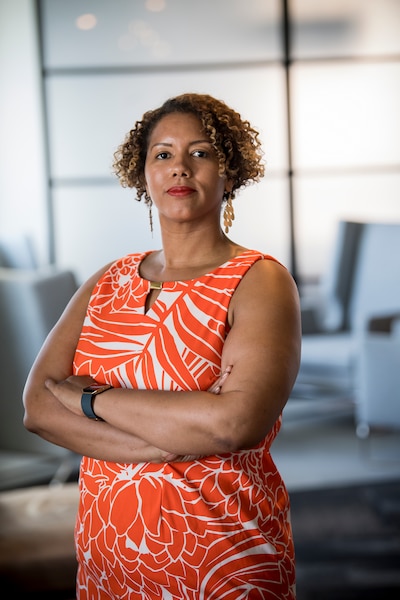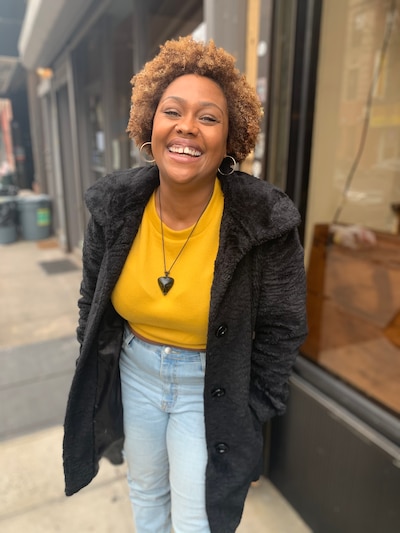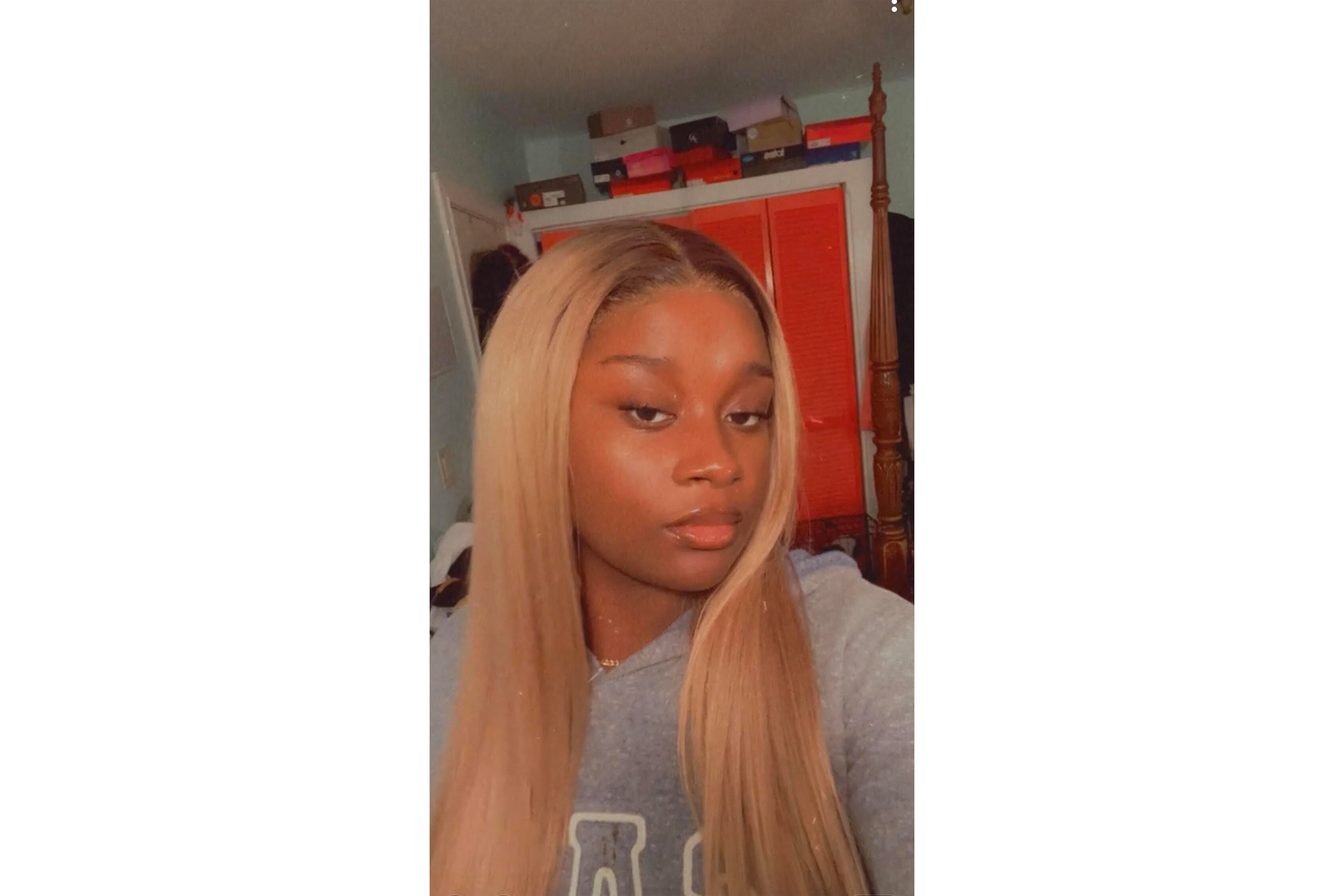The first thing Elizabeth Yarde noticed on her first day at Queens High School for the Sciences at York College was the lack of Black students.
The daughter of Caribbean immigrants, Yarde felt intense stares from other students, their looks seemingly questioning Yarde’s place at the elite high school, and she heard racial slurs being tossed around freely. At lunch, when Yarde started up a conversation with a fellow student, he remarked that he had never had a Black friend before.
“I started to slowly realize that a lot of these kids had kind of been sheltered from other races of people to the point where they didn’t really know how to be racially sensitive,” said Yarde, 17, who graduated Monday. “It seemed like kids were either automatically intimidated by me, or they immediately undermined me.”
As one of the eight specialized public high schools in the city where admissions is determined solely by the Specialized High School Admissions Test, or the SHSAT, York High School, as Yarde’s school is sometimes called, does not have a student body that comes close to representing the nation’s largest public school system. Asian American students account for more than 80% of the student body – about 480 students – while only 3% of students are Black, even though Black students make up roughly a quarter of students in New York City’s public schools.
Over the course of her freshman year, Yarde felt her mental health deteriorate. Panic attacks became regular occurrences. She often felt overwhelmed and ran to the bathroom to cry. Racist remarks from other students – such as one student’s comment that his mother would rather he be gay than date a Black girl – wore her down.
Yarde begged her mother to let her transfer to a different school, but her mother encouraged her to stay. As the youngest of 10 children, and the first to attend a specialized high school, she felt significant pressure not only to stick it out but also to perform well academically.
And she has. She is graduating with a 3.8 GPA, and she will start college in the fall at Northeastern University in Boston. A member of student government and the school’s student leadership team, Yarde discovered at York High School that she has a strong voice and deft communication skills. She aspires to be a lawyer or a marketing executive one day.
But Yarde’s academic success has come at a cost, one that she is not sure she would be willing to pay again.
“I don’t personally think it was worth it,” she said. “I don’t think that Black children should always have to face trauma in order to be stronger. The world is already very difficult as a Black child – walking down the street, going anywhere with your friends, always having to be so racially aware at such a young age. If you can have a safe place for four years, eight hours a day, five days a week, you go there.”
The nation’s most segregated school system
New York City’s public school system is the most segregated in the country. According to a recent report released by the UCLA Civil Rights Project, about 85% of Black students and about 75% of Latino students attend segregated schools in the city. Only 11% of white students and 43% of Asian American students do.
The racial divide is especially evident in the city’s specialized high schools. This year, only eight Black students were offered a seat at Stuyvesant out of 749 seats, and only one Black student got into Staten Island Technical High School. At York High School, 10 Black students were offered seats, an increase from last year’s 8.
Black and Latino students, who together make up almost 70% of the school system, received 9% of offers to specialized schools for the coming school year – a decline from 11% the year before, according to the education department.
For those Black and Latino students who do attend specialized schools, the experience often comes at a premium.
Last month, several Black and Latino students at the city’s specialized high schools spoke on a panel about their experiences dealing with racism at school. Students described administrators who failed to reprimand students for using a racial slur for Black people. Most said they experienced social anxiety at their schools, where they constantly felt on edge and at risk of being verbally harassed. Many students considered transferring to different high schools.
“Within the first week of school my worst fears were confirmed,” one student said. “Throughout the rest of my years, there have been many other microaggressions. It has moved me to activism. It’s a huge burden to place on Black and Hispanic students, because now we feel like we have to change the entire culture of our schools.”
The panel was organized by Teens Take Charge, an advocacy group representing teens from more than 30 New York City high schools. Desegregating schools is one of the group’s priorities.
Racism can be found in K-12 schools across the country, ranging from microaggressions — such as assuming someone got into a top school through affirmative action or marveling at how “well spoken” a student of color is — to overt hostility. These comments impact students’ mental health.
“When you experience racism day in and day out, it is like getting stung by a bee all day long,” said Takiema Bunche-Smith, executive director of the Center on Culture, Race, and Equity at Bank Street College of Education. “After a while, you start to swell and have a reaction. These reactions are not just physical. There’s also the mental and emotional stress of anxiety, depression and hopelessness and feeling like, ‘Why is it like this? This isn’t the way high school is supposed to be.’”

The city’s specialized high schools have not always been as segregated. When Bunche-Smith graduated from The Bronx High School of Science in the early 1990s, Black students made up about 15% of the student body.
“As the years have gone on and especially over the past 10 years, we’ve watched the numbers of Black students dwindle to next to none,” said Bunche-Smith. “I think we’ve [Black alums of specialized science high schools] just been really alarmed.”
Bunche-Smith said that representation matters in creating a safe environment for historically excluded students. When her own son was applying to high schools, she created a spreadsheet, noting the percentage of Black students at each of the schools he was considering.
“When I found that a school had less than 15% Black students, I put a little star next to it,” she said. “And I told my son, ‘I don’t think this is a school you should apply to because it doesn’t represent the racial demographics of the larger city and school system.’”
At York High School, Yarde found that having even a small group of other Black students to confide in was critical to surviving. She joined the Black Student Union, and she credits the group for helping her get through four tough years.
“It was a breath of fresh air,” Yarde said of the organization. “I finally felt like I had a safe place with people who understood what I was going through.”
Addressing high school admissions and specialized schools
Mayor Bill de Blasio has proposed reforms to the admissions process to the city’s specialized schools, but has accomplished little in his eight years in office. A proposal three years ago to scrap the exam — and admit top middle school students based on a combination of state test scores and school grades — failed. (One report found that replacing the SHSAT with other admissions criteria might not increase the share of Black students at specialized high schools.)
The test has long been contentious, with some Asian American groups as well as lawmakers lobbying against the mayor’s plan, which they said overlooked immigrant families.
Others, including Alexis Wint, a Black woman who teaches at M.S. 839, say removing the SHSAT is necessary to alleviate some of the problems Black students face at specialized high schools, as is dropping “screens,” including test scores and attendance, at other selective schools.

Wint attended Stuyvesant when she was a student in the late 2000s but left the school her junior year, a decision she attributes to the overt racism she experienced there.
Her breaking point came when the school organized a day during Spirit Week called “Ghetto Fabulous Day.” Although the school changed the name of the event after the Black Student Union noted the implicit racism, students still dressed inappropriately, in what Wint said “could only be called a Minstrel show.”
After that incident, Wint began cutting school. She applied to Bard College at Simon’s Rock, designed for students who want to start college early, and she wrote her admissions essay about her experiences with racism at Stuyvesant. She was accepted, but her teachers at Stuyvesant who read the essay dismissed what she had to say.
Like Yarde, Wint said she would not have gone to Stuyvesant had she known more about the school’s climate.
“It is almost impossible to excel academically when you’re not being nurtured emotionally and mentally,” she said, adding that most of her Black female friends from Stuyvesant are still going to therapy to address the trauma they endured while at the school.
Research has shown that integrated schools benefit students of all racial and ethnic backgrounds. Students who rarely spend time with classmates of other races can form harmful stereotypes about their peers.
For Yarde, this manifested in her high school classmates making assumptions about her temperament and academic abilities. When Yarde and other Black students were successful, such as in college admissions, other students chalked it up to affirmative action. If a Black student failed, they were called lazy.
“It just kind of felt like you could never really win,” said Yarde.
Racial segregation and trauma can start well before high school. Yarde remembers participating in the city’s DREAM program, which prepares students from low-income families for the SHSAT. While she credits the program with helping her get into a specialized high school, she is also critical of the program’s lack of resources.
“I remember the facility wasn’t always clean, and there sometimes weren’t enough lunches to feed all the students,” she said. “It just kind of shows the difference in resources that goes to programs aimed towards Black and Hispanic students.”
Disparities exist in lower grades, too. Pre-kindergarten classrooms are even more segregated than those in later grades, research has shown, and the quality of Pre-K programs for white and Asian American students is higher than those serving mostly Black and Latino students.
Bunche-Smith said desegregation is not a one-step antidote to racism in schools. Schools must also commit to being antiracist, she said.
“Without a commitment and a concrete plan of how to get there, schools are going to continue to reproduce personal, institutional and systemic racism,” said Bunche-Smith. “We know that because that’s the default setting of all schools and all institutions in the United States. If you’re not antiracist, then by default, you are reproducing racism.”
‘I’m not afraid anymore’
As Yarde considered where to go to college, she originally focused on applying to historically Black colleges and universities, or HBCUs. She said she had experienced enough racial trauma in high school and was ready for something different.
But having survived high school, Yarde also felt empowered to apply to any school that appealed to her. She visited Northeastern’s campus during her junior year and was attracted to the school’s co-op program, which alternates semesters of academic study with periods of full-time work. When she learned that Northeastern’s student body is about 3% Black — mirroring the demographics of her high school — she decided she would not let that stop her from applying.
“This is just another four-year experience in my life,” said Yarde. “I’m not afraid anymore. Nobody puts fear into my heart, and I don’t allow myself to get discouraged.”
As she looks back on the last four years, Yarde is still haunted by some of her traumatic experiences at York High School. She finds herself anxious sometimes, particularly in social settings with large groups of people who don’t look like her. And she advises other Black and Latino students to think twice before commiting to a specialized high school.
But Yarde also recognizes that she is leaving high school stronger than when she entered. She has become a person who confronts racism and other forms of injustice. She speaks confidently, as if there is nothing that could stop her from achieving her goals.
“This experience pushed me to be a strong presence,” she said. “I’ve just become more confident and comfortable with myself.”





